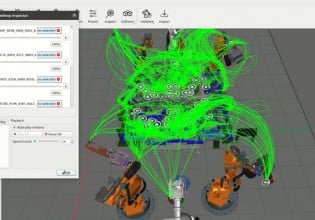Vibration Monitoring in Predictive Maintenance (PdM)
Advanced automation and IoT devices can detect vibration, but even complex systems can miss a variable and cause chaos.
Working with these systems requires years of experience in order to understand the importance of errors. Things don’t always add up and occasionally there seems to be some problem or variable happening behind the scenes that causes chaos.
The "Silver Tsunami"
It can be difficult to learn about certain unseen variables in school, and why experienced workers are invaluable to production. This tribal knowledge wasn’t much of a problem when older engineers could show the newer generation the ropes. However, the Silver Tsunami (AKA the wave of older engineers and technicians getting ready to retire) might remove years of experience and knowledge from companies.
Additionally, much of the equipment has been in use for decades, so much of the “chaos” variables have all been found and are understood. However, companies trying to stay on the cutting edge are continuously trying to upgrade, retrofit, or install new equipment. With so much change, it is important to focus on what is constant; basic understanding of these systems and equipment, and science.
While basic understanding comes with time and ability, the science aspect is relatively straightforward. If you think back to labs you’ve done in school, you might remember them as an interesting way to become hands-on with science. However, what happens when the numbers found in the experiment defies physics?
As technology moves into more complex control systems, the ability to notice incorrect numbers or understand raw data will become increasingly valuable.
For this article, excessive vibration will be used to show where preventative maintenance can help or hinder production.

Augury's technology providing machine diagnostics and other detections. Image used courtesy of Augury Inc.
Excessive Vibration: An IoT Vibration Sensor Example
An engineer connects a vibration sensor to a motor to detect vibration in a CNC mill. The sensor is new, shiny, and sends notifications when vibration exceeds a set value. The software accompanying the sensor also sends notifications about vibration history and suggests when and what type of maintenance should be done on the motor based on data.
After a few years of operation, the engineer is able to see that the motor with the IoT vibration sensor has received more maintenance on it than any other equipment. Every time the vibration sensor indicated a problem it was simple enough to schedule maintenance during downtime, but why would one motor need more bearings, lube, or newly sharpened bits than other machines?
An experienced engineer might think excessive vibration would be easy enough to solve, and the IoT sensor’s software would probably help lead an engineer or technician to something such as – a dull cutting edge, wearing bearings, alignment issues, check the coupler, etc.

Image used courtesy of Augury Inc.
Technology Can Only Suggest What It Knows
In short, a smart device can only work with what it is given. What the software might not know is anything that exists outside the vibration of the motor. As companies update equipment, variable speed drives are showing up in factories more and more. If your smart system wouldn’t suggest operating at a different speed if it isn’t aware that it is an option. Technology can only suggest what it knows.
If the motor is connected to a variable speed drive, it is possible to find the natural frequency of the system which would increase vibration. Seeing this vibration might lead to unnecessary maintenance or increase wear that would lead to increased maintenance.
Detecting the natural frequency of a machine can be hard. There are tests such as a sweep or bump tests that work. However, in this example, a continuous vibration sensor is already installed. An engineer or technician should understand the entire system to think for themselves if the cutting edge is dull, or if excessive vibrations are occurring at specific speeds.
Just because our machines are smart doesn’t mean we can assume we can only be doing what the machine tells us to. If you are noticing an increase in maintenance and problems with new technology you might want to go back to basics to find the root cause of an issue. Often times, it’s not the technology that’s the problem, but how it is applied.
What has been your experience with vibration detection? Have you faced issues with updating equipment?






